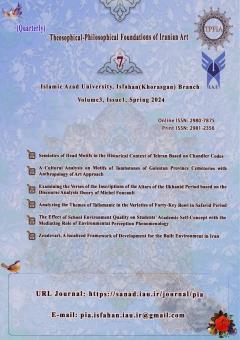A Cultural Analysis on Motifs of Tombstones of Golestan Province Cemeteries with Anthropology of Art Approach (Case study: Bandar-e-Gaz, Habibollah Imamzadeh Cemetery)
Subject Areas : Art
Fatemeh Raghimi
1
![]() ,
MohammadAli Khabari
2
*
,
Mohammad Aref
3
,
MohammadAli Khabari
2
*
,
Mohammad Aref
3
1 - Comparative and Analytical History of Islamic Art Group, Central Tehran Branch, Islamic Azad University, Tehran, Iran
2 - Assistant professor of art research group, Jahad University, Tehran, Iran
3 - Associate professor of theatre group, central Tehran branch, Islamic Azad University, Tehran, Iran
Keywords: Anthropology of Art, Culture, Habibollah Shrine, Motifs, Tombstones,
Abstract :
Among the truly prominent components of ritual arts, one can point to tombstones, whose engraved motifs reflect the locals’ ideology, culture, and worldview, providing a wide lens through which we can see the personality of the deceased and the social, economic, and cultural status of the related groups or nationalities. This article aims to analyze the motifs engraved on the tombstones of Habibollah Shrine (Bandar-e-Gaz, Golestan province) from a cultural point of view, considering that society is their creator. For this purpose, among the 10 cemeteries of Golestan province that were studied, the Habibollah Imamzadeh Cemetery in Bandar-e-Gaz was selected as a case study due to the number of gravestones and variety of motifs. This article tries to answer the following question: How can the semantic, aesthetic, and functional characteristics of these gravestone motifs be discovered through the Anthropology of Art approach based on findings on local culture? The research method is descriptive-analytical, with field observations and library studies conducted for data collection. Among the findings, one highlights the interpretation of three important dimensions of the motifs: semantic, aesthetic, and functional. Based on the cultural study, these motifs represent customs, beliefs, and various levels of society's culture.
آیتاللهی، حبیبالله (1392)، «تبیین مدخلهای زیباییشناسی فرش ایرانی»، پژوهش هنر، سال اول، شماره2، ص43-46.
السعید، عصام، پارمان، عایشه (1399)، نقشهای هندسی در هنر اسلامی، ترجمۀ مسعود رجبنیا، تهران، انتشارات سروش.
بهمنی، پردیس (1389)، سیر تحول و تطور نقش و نماد در هنرهای سنتی ایران، تهران، انتشارات دانشگاه پیام نور.
پویان، جواد و خلیلی، مژگان (1389)، «نشانهشناسی نقوش سنگقبرهای دارالسلام»، کتاب ماه هنر، شماره144، صص 107-98.
تناولی، پرویز (1388)، سنگقبر، تهران، انتشارات بنگاه.
جل، آلفرد (1390)، هنر و عاملیت: به سوی نظریۀ جدید انسانشناختی، ترجمۀ احمد صبوری، تهران، متن.
حاتم،غلامعلی (1374)، «نقش و نماد در سفالینههای کهن»، فصلنامه هنر، شماره 28، ص355-378.
سبحانی، سید جعفر (1393)، فرهنگ لغات و اصطلاحات عرفانی، تهران، طهوری.
شوالیه، ژان و گربران، آلن (1399)، فرهنگ نمادها، ترجمۀ سودابه فضائلی، تهران، کتابسرای نیک.
صداقت، معصومه (1384)، «مضامین مذهبی در خطنگارههای سنگمزارها و محرابهای موزه ملی»، مطالعات هنر اسلامی، شماره3، صص96-77. doi: 10.22034/IAS.2005.125673
فکوهی، ناصر (1400)، تاریخ اندیشه و نظریههای انسانشناسی، تهران، نی.
کوپر، جیسی (1392)، فرهنگ مصور نمادهای سنتی، ترجمۀ ملیحه کرباسیان، تهران، انتشارات فرشاد.
گروتر، یورگ کورت (1393)، زیباییشناسی در معماری، ترجمۀ مجتبی دولتخواه و سولماز همتی، تهران، جامع هنر.
معطوفی، اسدالله (1387)، سنگمزارها و کتیبههای تاریخی گرگان و استرآباد، تهران، حروفیه.
مورفی، هوارد (1385)، «انسانشناسی هنر»، ترجمۀ هایده عبدالحسینزاده، فصلنامۀ خیال، شماره17، ص20-69.
هال، جیمز (1398)، فرهنگنگارهای نمادها در هنر شرق و غرب، ترجمۀ رقیه بهزادی، تهران، انتشارات فرهنگ معاصر.
هوهنهگر، آلفرد (1395)، نمادها و نشانهها، ترجمۀ علی صلحجو، تهران، سازمان چاپ و انتشارات.
Firth, R. (1973), Tikopia art and society, In the Anthropology of Art: A Reader, Edited by H. Morphy and Perkins, Oxford: Blackwell Publishing.
Morphy, H (1989), "From Dull to Brilliant", The Aesthetics of Spiritual Power among the Yolngu, Man, 24(1), pp.21-40.
Morphy, H. (1994), the anthropology of art. In Companion Encyclopedia of Anthropology. (Ed.) T. Ingold, London & New York: Routledge.
Morphy, H. & Perkins, M. (2006), " The Anthropology of Art: A Reflection on its History and Contemporary Practice", In the Anthropology of Art: A Reader, Edited by H. Morphy & M. Perkins, Malden: Blackwell.

